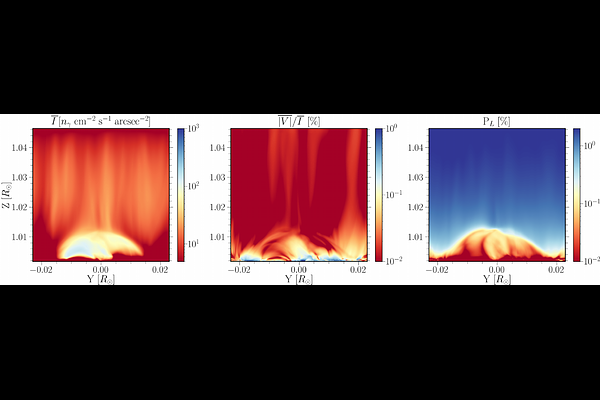Spectropolarimetric synthesis of forbidden lines in MHD models of coronal bright points

Spectropolarimetric synthesis of forbidden lines in MHD models of coronal bright points
Ernest Alsina Ballester, Daniel Nóbrega-Siverio, Fernando Moreno-Insertis, Supriya Hebbur Dayananda
AbstractThe inference of the magnetic field vector from spectropolarimetric observations is crucial for understanding the physical processes governing the solar corona. We investigate which information on the magnetic fields of coronal bright points (CBP) can be gained from the intensity and polarization of the Fe XIII 10747 A, Fe XIV 5303 A, Si X 14301 A, and Si IX 39343 A forbidden lines. We apply the P-CORONA synthesis code to a CBP model in the very low corona, obtained with the Bifrost code, and to a larger global model to study the impact of the outer coronal material along the line of sight (LoS). The enhanced density within the CBP produces an intensity brightening, but suppresses the linear polarization. The circular polarization from such regions often approaches 0.1% of the intensity. The contribution from the coronal material along the LoS depends strongly on its temperature, and is weaker for lines with a peak response at higher temperatures (Fe10747 at 1.7 MK; Fe5303 at 2 MK). The weak field approximation (WFA) provides information on the longitudinal magnetic fields in the strongest-emitting spatial intervals along the LoS, and is more reliable in the regions of the CBP where the field does not change sign. This tends to coincide with the regions where there is a strong correlation between the circular polarization and the wavelength derivative of the intensity. Considering roughly 30 minutes of time evolution, the CBP signals are somewhat attenuated but are still identifiable, while the area where the WFA can be suitably applied remains substantial. The circular polarization of the Fe5303 and especially Fe10747 lines are valuable diagnostics for the magnetic fields in the higher-temperature regions of the CBP, which could be exploited with future coronagraphs with similar capabilities to Cryo-NIRSP/DKIST, but designed to observe below 1.05 solar radii.